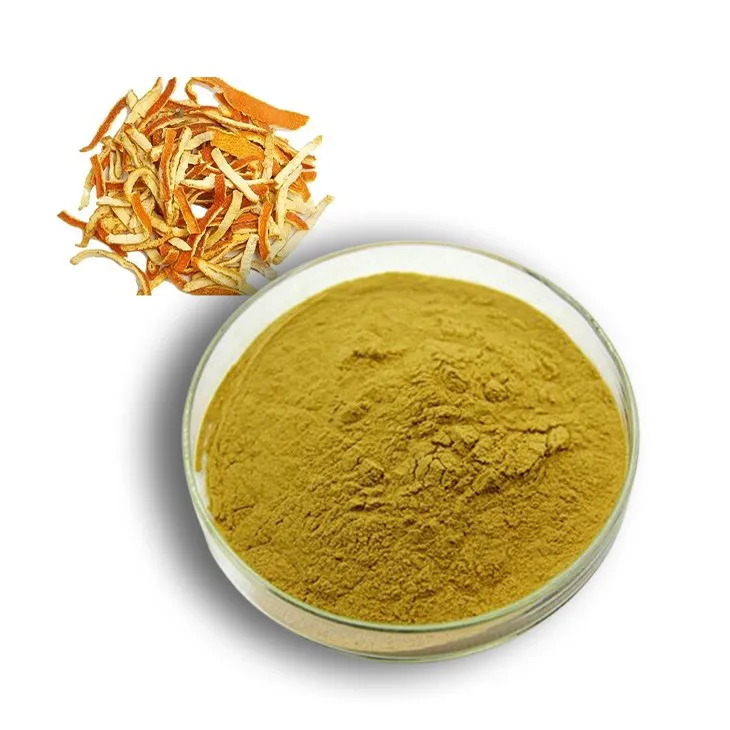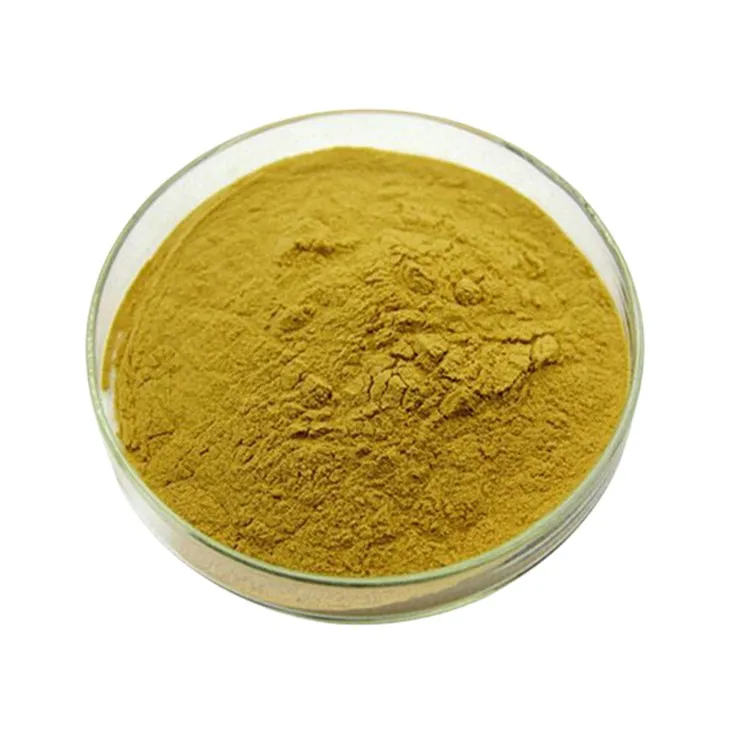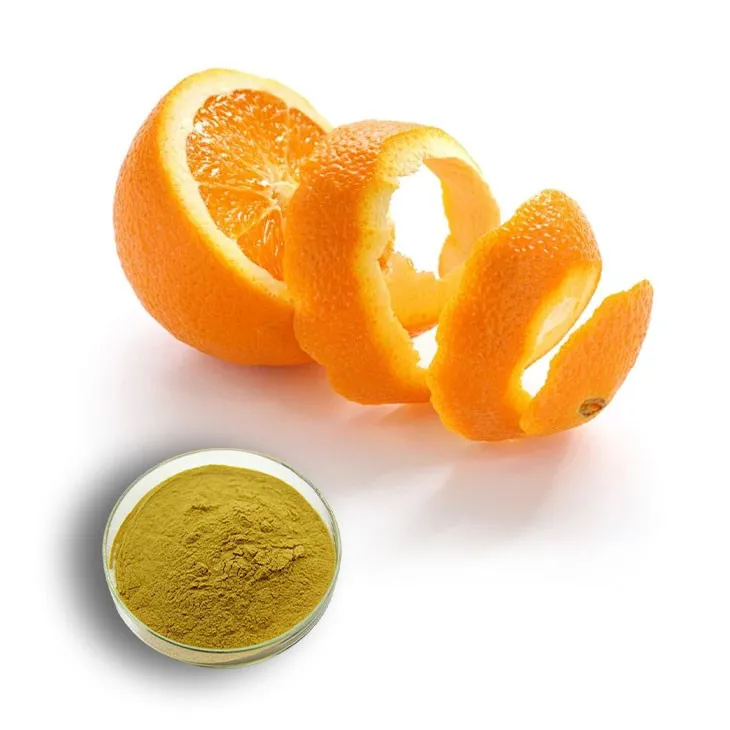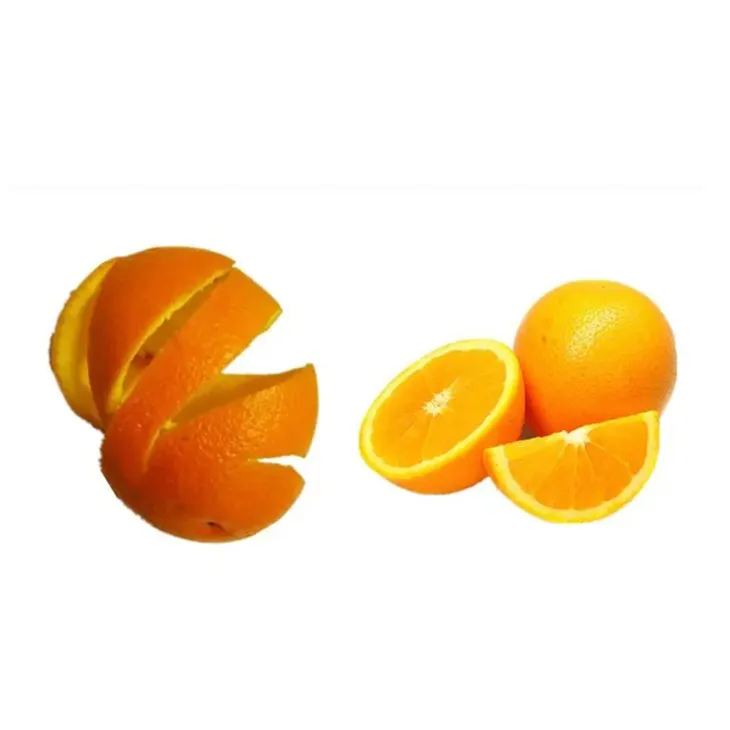- 0086-571-85302990
- sales@greenskybio.com
Manufacturer of Organic Hesperidin Powder.
2024-11-29

Introduction to Organic Hesperidin Powder
Organic Hesperidin powder is a remarkable natural product that has been gaining increasing attention in recent years. Hesperidin, a flavonoid, is predominantly found in the peel of oranges. It is known for its numerous beneficial properties, which have led to its wide - ranging applications across different industries.
The Chemical and Physical Properties
Hesperidin has a unique chemical structure that gives it certain physical characteristics. Chemically, it is a glycoside composed of the flavanone hesperetin and the disaccharide rutinose. It is a yellowish powder with a characteristic odor. Its solubility in water is relatively low, but it can be modified through various techniques during the manufacturing process to make it more suitable for different applications.
The Source: Orange Peels
Orange peels are the primary source of hesperidin. Oranges are widely cultivated around the world, and their peels, which are often considered a waste product in the citrus industry, have become a valuable resource for the production of hesperidin powder. However, not all orange peels are suitable for the production of high - quality organic hesperidin powder. Only those from organically - grown oranges can be used for organic hesperidin production.

Challenges Faced by Organic Hesperidin Powder Manufacturers
1. Sourcing of Organic Orange Peels
One of the major challenges for manufacturers of organic hesperidin powder is the sourcing of organic orange peels. Finding reliable suppliers is crucial. This requires building long - term relationships with farmers who practice organic farming methods. Organic farming is more labor - intensive and often more expensive than conventional farming, which can lead to higher raw material costs for the manufacturers.
Ensuring a consistent supply of orange peels throughout the year can also be a problem. Orange harvest seasons vary by region, and manufacturers need to coordinate with multiple suppliers to maintain a steady flow of raw materials. Additionally, they must ensure that the orange peels are free from pesticides, herbicides, and other contaminants, as these substances are not allowed in organic products.
2. Quality Control
Quality control is another significant challenge. The quality of the hesperidin powder depends on several factors, including the quality of the orange peels, the extraction and purification methods used, and the storage conditions. Manufacturers need to implement strict quality control measures at every stage of the production process.
During the extraction process, for example, it is essential to ensure that the hesperidin is extracted efficiently without being degraded. This requires precise control of temperature, pressure, and extraction time. In the purification stage, any impurities such as other flavonoids or non - hesperidin compounds need to be removed to obtain a high - purity product. Storage conditions, such as temperature and humidity, also play a role in maintaining the quality of the hesperidin powder over time.
3. Regulatory Compliance
The production of organic hesperidin powder is subject to various regulations. Manufacturers need to comply with organic certification standards, which may vary from country to country. These standards govern everything from the sourcing of raw materials to the manufacturing process and labeling of the final product.
For example, in the European Union, products labeled as "organic" must meet strict criteria regarding the use of fertilizers, pesticides, and the overall production process. In the United States, the USDA has its own set of organic certification requirements. Non - compliance can result in hefty fines and damage to the company's reputation.

Opportunities for Organic Hesperidin Powder Manufacturers
1. Growing Demand in the Food Industry
The food industry presents a significant opportunity for organic hesperidin powder manufacturers. Hesperidin has been recognized for its potential health benefits, such as antioxidant, anti - inflammatory, and cardiovascular - protective properties. As consumers become more health - conscious, there is a growing demand for functional foods and beverages that contain natural ingredients like hesperidin.
Manufacturers can develop products such as fortified juices, energy bars, and dietary supplements that contain hesperidin powder. These products can target health - conscious consumers, athletes, and those with specific health concerns. For example, hesperidin - enriched juices can be marketed as a healthy alternative to regular juices, with the added benefit of the flavonoid's health - promoting properties.
2. Pharmaceutical and Nutraceutical Applications
In the pharmaceutical and nutraceutical industries, hesperidin powder has great potential. Research has shown that hesperidin may have applications in the treatment or prevention of various diseases, such as diabetes, hypertension, and certain types of cancer. Pharmaceutical companies are increasingly interested in exploring the medicinal properties of hesperidin.
Nutraceutical manufacturers can develop products that combine hesperidin with other nutrients and bioactive compounds to create supplements aimed at improving overall health. These products can be sold over - the - counter and are often considered a more natural alternative to prescription drugs for certain mild health conditions.
3. Cosmetics and Skincare
The cosmetics and skincare industries are also emerging markets for organic hesperidin powder. Hesperidin has antioxidant properties that can help protect the skin from damage caused by free radicals. It can also improve skin elasticity and reduce the appearance of wrinkles.
Manufacturers can incorporate hesperidin powder into creams, lotions, and serums. These products can be marketed as anti - aging or skin - rejuvenating treatments. For example, a hesperidin - based cream can be promoted for its ability to brighten the skin, reduce inflammation, and improve overall skin texture.

The Manufacturing Process of Organic Hesperidin Powder
1. Extraction
The first step in the manufacturing process is the extraction of hesperidin from orange peels. There are several extraction methods available, including solvent extraction, supercritical fluid extraction, and enzymatic extraction.
Solvent Extraction
Solvent extraction is a commonly used method. Organic solvents such as ethanol or methanol are used to dissolve the hesperidin from the orange peels. However, this method has some drawbacks, such as the need for solvent removal and potential solvent residues in the final product.
Supercritical Fluid Extraction
Supercritical fluid extraction, using substances like carbon dioxide in a supercritical state, is a more advanced and cleaner extraction method. It offers advantages such as high selectivity, no solvent residues, and the ability to operate at relatively low temperatures, which helps preserve the integrity of the hesperidin.
Enzymatic Extraction
Enzymatic extraction involves using enzymes to break down the cell walls of the orange peels, facilitating the release of hesperidin. This method is considered more environmentally friendly, but it may require more complex process control compared to other methods.
2. Purification
After extraction, the hesperidin - rich extract needs to be purified. Purification methods include chromatography, crystallization, and membrane filtration.
Chromatography
Chromatography is a powerful technique for separating hesperidin from other compounds in the extract. High - performance liquid chromatography (HPLC) is often used in the industry to achieve high - purity hesperidin.
Crystallization
Crystallization is another method for purifying hesperidin. By carefully controlling the temperature, concentration, and other parameters, pure hesperidin crystals can be obtained.
Membrane Filtration
Membrane filtration can be used to remove impurities based on their molecular size. This method is relatively simple and can be an effective step in the purification process.
3. Powder Formation
Once the hesperidin has been purified, it is converted into a powder form. This can be achieved through techniques such as spray drying or freeze - drying.
Spray Drying
Spray drying involves spraying the hesperidin solution into a hot drying chamber, where the water evaporates quickly, leaving behind a fine powder. This method is efficient and can produce a powder with good flowability and solubility.
Freeze - Drying
Freeze - drying, also known as lyophilization, involves freezing the hesperidin solution and then removing the water under vacuum. This method is more gentle and can preserve the structure and activity of the hesperidin better, but it is also more expensive.

Product Development by Organic Hesperidin Powder Manufacturers
Product development is a crucial aspect of the work of organic hesperidin powder manufacturers. They need to collaborate closely with their customers to develop customized formulations of hesperidin powder that meet specific requirements.
1. Collaboration with Food Companies
When working with food companies, manufacturers need to consider factors such as taste, solubility, and stability of the hesperidin powder in food matrices. For example, if the hesperidin powder is to be added to a fruit - flavored beverage, it should not affect the original taste of the beverage. It should also be soluble enough to be evenly distributed throughout the product.
Manufacturers may develop different grades of hesperidin powder for food applications, depending on the desired properties. For instance, a high - solubility grade may be developed for clear beverages, while a more stable grade may be suitable for baked goods.
2. Collaboration with Pharmaceutical Firms
With pharmaceutical firms, the focus is on developing hesperidin - based formulations for drug delivery or as dietary supplements. The bioavailability of hesperidin needs to be considered, as well as its compatibility with other active ingredients and excipients.
For example, if hesperidin is to be used in a tablet formulation, it should be compressed easily without losing its activity. Manufacturers may also need to develop formulations that can improve the absorption of hesperidin in the body, such as by encapsulating it in liposomes or other delivery systems.
3. Collaboration with Cosmetics Manufacturers
When collaborating with cosmetics manufacturers, the texture, appearance, and stability of the hesperidin - containing product are important. The hesperidin powder should blend well with other ingredients in creams, lotions, or serums.
Manufacturers may develop hesperidin formulations with specific skin - targeting properties, such as enhanced penetration into the skin layers or long - lasting antioxidant effects. They may also need to consider the packaging of the final product to ensure the stability of the hesperidin - containing cosmetics.
Environmental Sustainability in Organic Hesperidin Powder Manufacturing
Environmental sustainability is an increasingly important aspect of the operations of organic hesperidin powder manufacturers.
1. Minimizing Waste in the Production Process
During the production process, manufacturers strive to minimize waste. For example, in the extraction process, they can optimize the use of solvents to reduce waste generation. Any by - products or residues from the extraction and purification steps can be recycled or repurposed if possible.
Orange peels, which are the raw material source, can also be fully utilized. After the extraction of hesperidin, the remaining peel can be used for other purposes, such as in the production of animal feed or compost.
2. Energy - Efficient Manufacturing
Manufacturers are also looking for ways to make their manufacturing processes more energy - efficient. This can include using energy - efficient equipment for extraction, purification, and powder formation. For example, modern spray - drying equipment with improved heat recovery systems can reduce energy consumption.
Some manufacturers may also explore alternative energy sources, such as solar or wind energy, to power their production facilities. This not only reduces their carbon footprint but also helps in long - term cost savings.
3. Sustainable Packaging
The choice of packaging for organic hesperidin powder is also an important consideration for environmental sustainability. Manufacturers are increasingly using recyclable or biodegradable packaging materials. For example, they may use paper - based packaging with a minimal amount of plastic or use fully biodegradable plastics.
Reducing the size and weight of the packaging can also contribute to environmental sustainability. This can be achieved through optimized product design and packaging engineering, which can also reduce transportation costs and associated carbon emissions.
FAQ:
What are the main challenges for organic hesperidin powder manufacturers in sourcing?
The main challenge is finding reliable suppliers of organic orange peels. They need to build relationships with farmers who follow organic farming practices to ensure a consistent supply of raw materials that are free from pesticides and other harmful substances.
How important is modern technology in the manufacturing process of organic hesperidin powder?
Modern technology is extremely important. Manufacturers use state - of - the - art equipment to extract, purify, and convert the hesperidin from orange peels into a fine powder, which can then be easily incorporated into different products.
What is the role of product development for organic hesperidin powder manufacturers?
Product development is crucial. Manufacturers work closely with customers such as food companies, pharmaceutical firms, or cosmetics manufacturers. They develop customized formulations of hesperidin powder to meet specific requirements, like creating a certain taste profile and solubility in the food industry.
How do organic hesperidin powder manufacturers contribute to environmental sustainability?
They strive to minimize waste during the production process and ensure that their operations have a minimal impact on the environment.
What are the applications of organic hesperidin powder?
Organic hesperidin powder has a wide range of applications in various industries such as food, pharmaceutical, and cosmetics industries.
Related literature
- Organic Hesperidin: Properties and Industrial Applications"
- "The Production and Quality Control of Organic Hesperidin Powder"
- "Sustainable Sourcing in Organic Hesperidin Powder Manufacturing"
- ▶ Hesperidin
- ▶ Citrus Bioflavonoids
- ▶ Plant Extract
- ▶ lycopene
- ▶ Diosmin
- ▶ Grape seed extract
- ▶ Sea buckthorn Juice Powder
- ▶ Fruit Juice Powder
- ▶ Hops Extract
- ▶ Artichoke Extract
- ▶ Mushroom extract
- ▶ Astaxanthin
- ▶ Green Tea Extract
- ▶ Curcumin
- ▶ Horse Chestnut Extract
- ▶ Other Product
- ▶ Boswellia Serrata Extract
- ▶ Resveratrol
- ▶ Marigold Extract
- ▶ Grape Leaf Extract
- ▶ New Product
- ▶ Aminolevulinic acid
- ▶ Cranberry Extract
- ▶ Red Yeast Rice
- ▶ Red Wine Extract
-
Yellow Pine Extract
2024-11-29
-
Kelp Extract Powder
2024-11-29
-
Saponin Extract
2024-11-29
-
Carrageenan Extract Powder
2024-11-29
-
Feverfew Extract
2024-11-29
-
Aminolevulinic acid
2024-11-29
-
Mulberry leaf Extract
2024-11-29
-
Clove Powder
2024-11-29
-
Cactus Extract
2024-11-29
-
American Ginseng Root Extract
2024-11-29





















